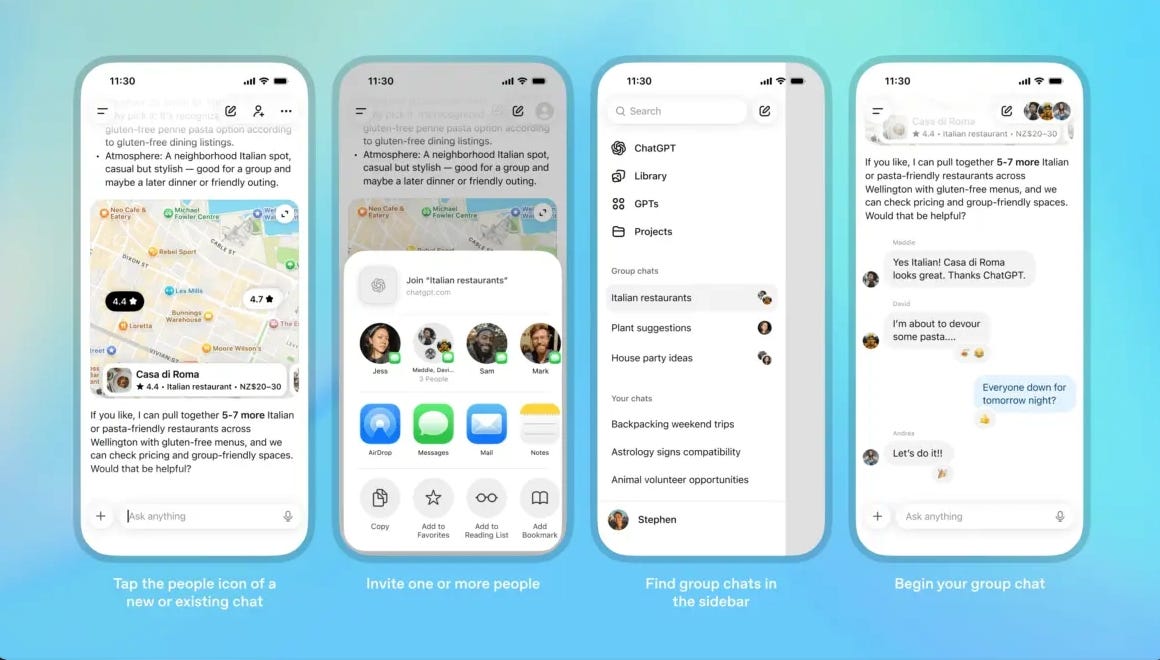In November 2024, OpenAI quietly dropped one of its most social updates yet: group chats with ChatGPT. And while it might sound like just another feature rollout, this change hints at something bigger — the rise of AI-assisted group communication.
Currently, the feature is rolling out in Japan, New Zealand, South Korea, and Taiwan, with additional regions expected to join soon. But even in early access, it already feels like a preview of how digital conversations might look in the near future.
What Exactly Are AI Group Chats?
The idea is simple but surprisingly powerful: up to 20 real people can join a single conversation, and ChatGPT becomes the 21st participant — jumping in when needed, staying quiet when not.
No more “Hey ChatGPT, reply above” moments.
No more dumping long prompts into chats.
Instead, the AI listens, waits, and only speaks when someone directly mentions it or when the context truly needs its voice. It’s natural, almost eerie, and very… futuristic.
Built on GPT-5.1 — The New Autopilot of Conversations
Group chats run on GPT-5.1, OpenAI’s newest model released in November. It doesn’t just respond; it decides when to respond.
Think of it like the friend who knows exactly when to join a discussion — and when to let everyone argue in peace.
GPT-5.1 in group mode can:
- handle multiple conversational threads at once
- track who asked what
- interpret reactions, images, and voice messages
- search the internet for missing info
- analyze files dropped into the chat
- respond directly to one person or the whole group
It’s the first time an AI has been explicitly trained to manage multi-human dynamics, not just one-on-one chats.
Yes, Even Free Users Get It
One of the most surprising decisions:
Group chats are available on the free tier as well.
This means schools, clubs, hobby groups, and small teams can start using AI in group settings without incurring any costs.
It’s especially interesting for:
- students collaborating on assignments
- startup founders brainstorming remotely
- travel groups planning itineraries
- writers running idea workshops
- families organizing events
The ceiling is low (only 20 people per group), but the potential is high.
Privacy Thought Through: Your Private Chat History Stays Private
A quiet but important detail:
ChatGPT doesn’t pull your private memories into group conversations.
That means even if you’ve been chatting with the AI daily about your personal tasks, anxieties, or business ideas, none of that enters the group space unless you introduce it.
It’s a separation of worlds that feels intentional and reassuring.
Kid-Safe by Default
One interesting safeguard: if a minor is present in the group, sensitive content is automatically restricted.
This includes both what the AI shows and what it chooses not to show. It’s one of the first AI group chat systems that automatically adjusts itself based on the room’s composition.
This makes it suitable for:
- school projects
- teen study groups
- family chats
- youth communities
For a feature that might quickly go mainstream, this kind of built-in protection feels essential.
How Group Chats Work in Practice
As soon as you create a group, you get a simple user profile — name, photo, and a short bio — just enough for other participants to recognize you.
From there, everything feels like a seamless mix of messaging app and AI workspace:
- You can upload images and ask the AI to analyze them.
- You can drop files and let ChatGPT summarize or compare them for you.
- You can send voice messages and get instant feedback.
- You can brainstorm ideas as a group.
- You can let ChatGPT mediate debates (gently… or firmly, depending on your request).
Invite links make joining easy, and anyone with the link can join as long as the group hasn’t reached the 20-person limit.
Why This Update Matters
This isn’t just about chatting with friends and an AI.
This is the first mainstream interface for multi-human + AI collaboration.
Until now, AI has been mostly a one-on-one experience.
Group chats change that paradigm completely.
They let AI:
- observe social dynamics
- support multiple people simultaneously
- provide information right inside human conversations
- act like a shared assistant, not a personal one
- become part of group decision-making
It’s not hard to imagine future workplaces where every team chat includes an AI participant by default — taking notes, organizing thoughts, catching errors, and providing unbiased input.
A Glimpse of What’s Coming
Group chats are still in early rollout, but they feel like the first step toward something bigger:
- AI moderators for online communities
- mixed-reality group sessions with persistent AI agents
- Teamwork tools where AI contributes as a full team member
- classrooms augmented by collaborative AI facilitators
For now, it’s just 20 humans and a very intelligent machine in one room.
However, the potential is far greater than that.
Final Thoughts
This new feature makes ChatGPT feel less like a personal assistant and more like a shared intelligence — something that lives inside group conversations rather than outside of them.
It’s quiet when it needs to be.
Helpful when asked.
And surprisingly good at navigating the chaos of human group chats.
If this is the future of communication, it’s starting in a small handful of countries — one group chat at a time.
Exploring the evolving dialogue between humans and artificial minds.
From neural networks and prompt engineering to digital philosophy and the ethics of intelligence — Digital Cortex is where data learns to think and creativity becomes computational.Here, technology isn’t just coded — it’s contemplated.
